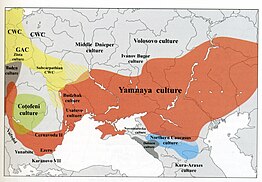
Back Ussatowe-Kultur German Cultura de Usatovo Spanish Culture d'Usatovo French Usatovokulturen NB Kultura usatowska Polish Усатовская культура Russian Усатівська культура Ukrainian
 | |
| Geographical range | Northwest Black Sea |
|---|---|
| Period | Copper Age |
| Dates | ca. 3650–2740 BCE |
| Preceded by | Mikhaylovka culture, Kemi-Oba culture, Cucuteni–Trypillia culture, Cernavodă culture |
| Followed by | Yamnaya culture, Ezero culture, Coţofeni culture, Baden culture, possibly Troad, Aegean civilisation (?) |
| Part of a series on |
| Indo-European topics |
|---|
 |

The Usatove culture (Usatove in Ukrainian, Usatovo in Russian) is an Eneolithic group of the northwest and west Pontic region (ca. 3650-2740 BCE),[1] with influences from the Cucuteni–Trypillia culture as well as the Eneolithic steppe cultures of the North Pontic. Usatove culture flourished west and northwest of the Black Sea in more than 50 sites.[2] The culture got its name from the village of Usatove in the Odesa Oblast of Ukraine.[3]
The Usatove culture appears to be a mixture of the Eneolithic agrarian cultures of Southeast Europe, with influences from the steppe cultures from the Pontic steppe. The Eneolithic farming culture influences on Usatove include clay figurines and painted ceramics, while it shares tumulus (kurgan) burials and shell-tempered coarse wares with steppe cultures. It also displays items made of metal, such as arsenical bronze and silver, which suggests contacts with the North Caucasus as well as Anatolia.
In Ukraine, Usatove culture sites are predominantly located in the Dniester-Danube interfluve. The two largest Usatove archaeological sites in Ukraine, Usatove-Velykyj Kuyalnik and Mayaky,[4] contain kurgan and ground cemeteries (necropoli).
Within the Kurgan hypothesis, the Usatove culture represents the domination of native Cucuteni–Trypillia agriculturalists by Indo-European peoples from the steppe. According to Anthony, the roots of the pre-Germanic languages lay in the Usatove culture.[5]
While the generally accepted chronological placement of Usatove is in the second half of the 4th millennium BCE, radiocarbon dates on human remains identified as Usatove are consistently older. Most of these dates cluster around the last quarter of the 5th - first quarter of the 4th millennium BCE.[6][7] It is likely that the dates on human remains are influenced by aquatic reservoir effect, the precise quantification of which is not possible at the moment due the lack of radiocarbon and stable isotope data from contextual faunal remains.
- ^ Nikitin et al. 2022, p. 3: "Established dating, based on material culture, such as the presence of imports of ceramics from securely dated chronological periods, as well as radiometric radiocarbon dates on charcoal, pottery, and animal bone, primarily from the ditches of the Mayaky sanctuary (Table S1a), place the Usatove culture in the chronological period corresponding to ca. 3650-2740 BCE".
- ^ Nikitin 2022, p. 148: "[C]oinciding with the Trypillia stage CII of chronological periodization of the Pre-Cucuteni–Cucuteni–Trypillia Culture Complex (PCCTCC)...[t]here are over 50 sites known of Usatove in the west and northwest Pontic Region".
- ^ "Entry Display Web Page".
- ^ Nikitin 2022, p. 148: "The two major Usatove culture sites in Ukraine, Usatove–Velykyj Kuyalnik and Mayaky, produce a picture of Usatove as an amalgam of steppe and agrarian influences".
- ^ Anthony 2007, p. 359-360.
- ^ Mattila et al. 2023.
- ^ Nikitin et al. 2022, p. 12: "Taken together, the late 5th millennium Eneolithic dates obtained on human remains, whether or not affected by a RE [reservoir effect], as well as the finds of Trypillian A-BI period ceramics at Mayaky (Petrenko, 2009), corroborate the existence of proto-Usatove burials at the Mayaky complex, not readily distinguished in the field from the late Eneolithic Usatove burials".